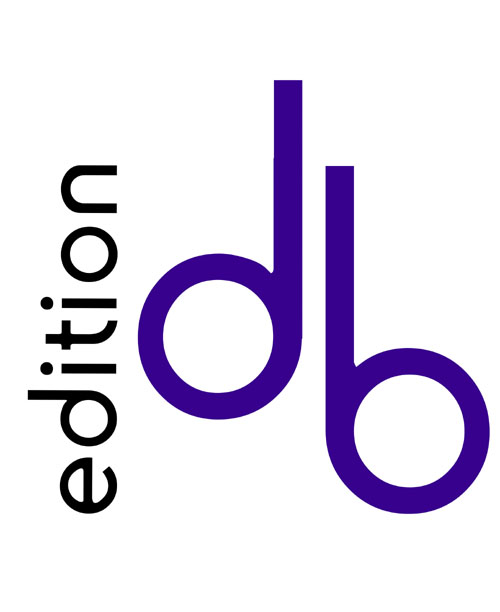
- 7 clarence grove
- horsforth
- leeds, LS18 4LA
- UK
- tel: 0113 258 1300
- order online
- order by fax
- www.editiondb.com
- 0113 258 2556
- info@editiondb.com
Review - Horn Trio for horn, violin and piano by Anthony Randall
edb 0703004 Chamber Music series
Anthony Randall’s Horn Trio consists of four movements: ‘Introduction-Pastorale,” ‘Scherzo,” “In Memoriam (Marian Cooper-Smith),” and “Finale.” While there are no program notes other than a brief biographical sketch, and no dedication other than that for the third movement, it appears the work is an expressive and inspired homage to Brahms, featuring many of the structural and stylistic characteristics of the Brahms trio with a creative, fresh, twenty-first century skew.
Randall has a gift for writing appealing and memorable melodies that he contrasts with more intensely chromatic ones such as that in the introduction of the first movement, a serene Andante that sets the mood for the slow pastorale mostly in 7/8, contrasted by a lilting waltz. His meter changes and rhythms seem to reflect the natural asymmetrical patterns of language: he apparently has a deep appreciation for poetry, judging by his compositions that include voice. Anthony Halstead has described some of Randall’s melodies as “evoking half-forgotten folk-tunes,” and I feel very much afraid that I should be able to name some of the themes or motives he honors! His writing for all three instruments reflects appreciable compositional skill as well as artistry and a special sense fort manipulating timbres and resonances. In the piano part, an occasional brief passage evokes the handfuls of notes and accidentals of Brahms chamber music, but most of it is clearer and more contrapuntal, with lots of octaves in each hand or between the two hands. The horn part has the expressiveness and technical demands one would expect from Randall, enhanced with an effective use of just a few extended techniques. I believe it may be very tempting to perform the third movement by itself as a moving elegy for solemn occasions.
Randall has had a truly illustrious career in London as a performer, professor, and conductor, as well as a composer. Eight of his pedagogical compositions for horn and piano have been listed as London College of Music exam pieces since 1994, and the British Horn Society Music Library loans three of his horn quartets to its members; but it is only in recent years, through the efforts of edition db, that his newer works are commanding the international attention (and availability) they deserve. The edition db website currently lists seven compositions and includes reviews previously published in both The Horn Call and The Horn Player.
Virginia Thompson, The Horn Call, IHS, Vol XLII No.1, October 2011
_________________________________________________________________________________________________________________________________
Review - Horn Trio for horn, violin and piano by Anthony Randall
edb 0703004 Chamber Music series
Additions to the repertoire in the horn, violin and piano configuration are always welcome and yet slightly tricky to programme in the concert hall. They either stand next to the giants of the genre, the Brahms and the Ligeti in attempting to imitate their stature or they succeed by concentrating on other musical matters. This new trio by Anthony Randall is a large-scale work in four movements which, while original in musical material, closely follows the movement pattern of the Brahms.
The opening movement, Introduction-Pastorale, begins with a figure in octaves in the piano that soon moves into a 7/8 pastorale. The mood is not idyllically pastoral but somewhat enigmatic and darkly brooding in places. The following 3/4 scherzo movement that follows is occasionally altered by random 5/4 bars and the Trio moves rapidly into a quasi cadenza section followed by a slow one. Like its famous forbears, the emotional centre of the work is the 3rd movement lament (3rd mvt. Brahma, 4th mvt. Ligeti) here simply titled In Memoriam. The Finale is a brisk compound time movement that alludes to the Pastorale before closing with an energetic accelerando.
As one would expect, the horn writing is idiomatic and very playable. The range is predominantly in the high register, but not excessively so, and there are occasional forays into the lower register. The pacing is also very well managed without too much concerted blowing without rests. I have a slight quibble with the different types of information concerning how to play but don’t wish to detract from the creative consideration of the music by raising purely notational issues. In brief, there are verbal tempo markings such as the 1st movement Andante but then a numeric metronome marking for the 2nd movement. The 2nd movement begins with a one bar accelerando but it is not clear from which tempo unless it is that of the previous movement, in which case should that movement follow attacca?
Also some of the instructions for muting, while specific in terms of equipment, variously calling for fibre and brass mutes, do not refer to the type of sound to be produced. Should the brass mute be very slightly forced (like hand-stopping) or just played as is? Really these are all questions which will answer themselves in time and through working with the composer. On the plus side the edition is beautifully produced and the layout is very easy to read. Any initial problems of negotiating one’s way through the score, such as repeats and D.C.s can easily be resolved by study.
This is a work that would fit well into any chamber music programme and I look forward to hearing it soon.
Roger Montgomery, The Horn Player, BHS, Autumn 2010
_________________________________________________________________________________________________________________________________